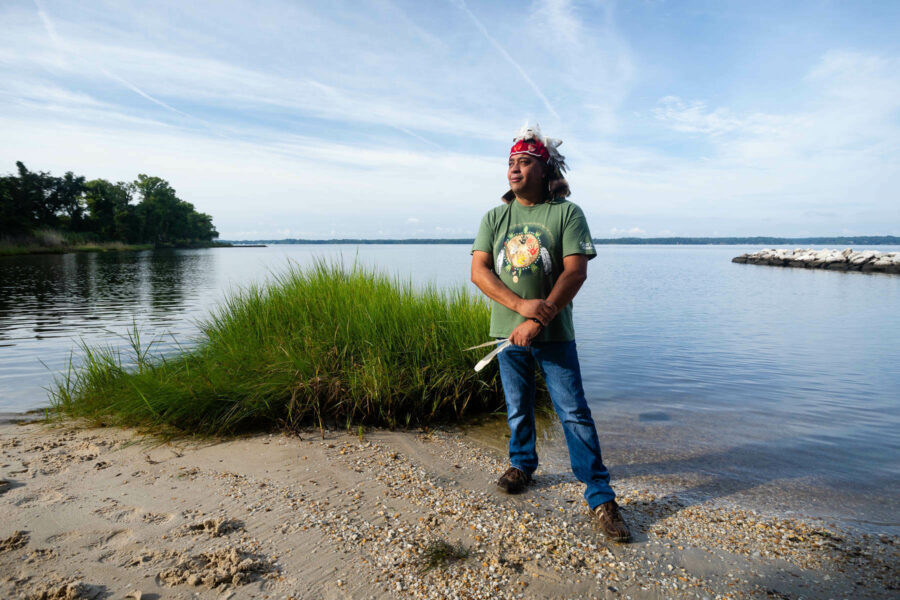An Indigenous tribe conserves its ancestral landscapes

For thousands of years, the Piscataway people thrived along the tributaries of the Chesapeake Bay. The Piscataway formed their practices, traditions and identity based on their close relationship with the environment. Despite the hardships of disease, intertribal provocations and displacement by English colonists, the Piscataway persisted. To this day, the Piscataway continues to reclaim their history, share their cultural significance with the public and lead meaningful environmental protection efforts.
A brief history of the Piscataway
Before the arrival of English colonists, the Piscataway were one of the dominant indigenous confederacies within the Chesapeake Bay region. Made up of an alliance of several small bands, the Piscataway lived in settlements throughout the peninsula of southern Maryland, between the Potomac River and the Chesapeake Bay and northward to the Patapsco, including what is now the District of Columbia.
The first historical recordings of the Piscataway begin in 1608 when Captain John Smith sailed up the Potomac River and encountered the Piscataway people inhabiting settlements such as Nacochtank, which is now considered Anacostia in the District of Columbia. In 1634, the Ark and Dove, which carried Maryland’s first English colonists, arrived at the Yaocomoco settlement, now known as St. Mary’s City. The Piscataway people welcomed these colonists, but as English populations grew, settlers began to encroach on the Piscataway’s lands.
The colonists created treaties with the Piscataway, which promised peace and equal treatment in exchange for their submission to European control. As a part of the treaty agreements, Piscataway lands were parceled into reservations. The Piscataway inhabited these reservations with the agreement that disturbances from English encroachments would no longer occur. Unfortunately, the colonists did not honor these treaties and the infringements on their lands continued.
In the name of self-preservation, some Piscataway bands splintered off from the alliance in search of new and more isolated land. The largest Piscataway group migrated to settlements along the Susquehanna River in Pennsylvania, where they became known as the Piscataway Conoy Tribe.
Through activism and perseverance, the Piscataway Conoy people reasserted their political and cultural presence in the Chesapeake Bay region, with many members returning to their ancestral land, particularly in southern Maryland. In 2012, the Piscataway Indian Nation and Piscataway Conoy Tribe became the first native people in Maryland to receive state recognition.
Protecting their land and waterways
Today, the Piscataway Conoy Tribe demonstrates a robust regional presence through environmental conservation and protection.
Over several years, former Piscataway Conoy Tribal Councilman, Francis Gray, has identified organizations and individuals with common environmental goals, such as the Potomac Riverkeeper Network. The Piscataway Conoy and the Potomac Riverkeeper Network partner to lead educational kayak trips along the Potomac River. These tours emphasize to the public the environmental and cultural importance of conservation.
The Potomac River Network has also aligned with the Piscataway Conoy to find and fight sources of pollution in the Bay that perpetuate environmental justice issues and hamper restoration goals. These efforts have led to the discovery of environmental threats such as a massive sewage spill at Mattawoman Creek. Coordinated advocacy between the Piscataway Conoy and conservation groups also contributed to the cancelation of the controversial Atlantic Coast Pipeline Project.
For the Piscataway Conoy, protecting the rivers enjoyed by their ancestors for thousands of years is vital to preserving their heritage and ensuring their ability to thrive now and in the future.
“Why would you poison the water that you drink from, why would you poison the water that you pull fish from…that you’re putting back into your body?” asks former Councilman Francis Gray. “Just because it goes down the river doesn’t mean that it disappears.”
To learn more about the Piscataway Conoy Tribe visit http://www.piscatawayconoytribe.com/

Comments
I hate the fact that the beloved American Indians have been treated like they and still do. They need to be recognized ABOVE EVERYONE ELSE. THESE BEAUTIFUL PEOPLE SUFFERED AT THE HANDS OF PEOPLE WHO WERE SUPOSE TO BE HUMANS.
This is the best, most comprehensive information I have read to date regarding the People whose original land we occupy.
Thank you!
Your comment has been received. Before it can be published, the comment will be reviewed by our team to ensure it adheres with our rules of engagement.
Back to recent stories